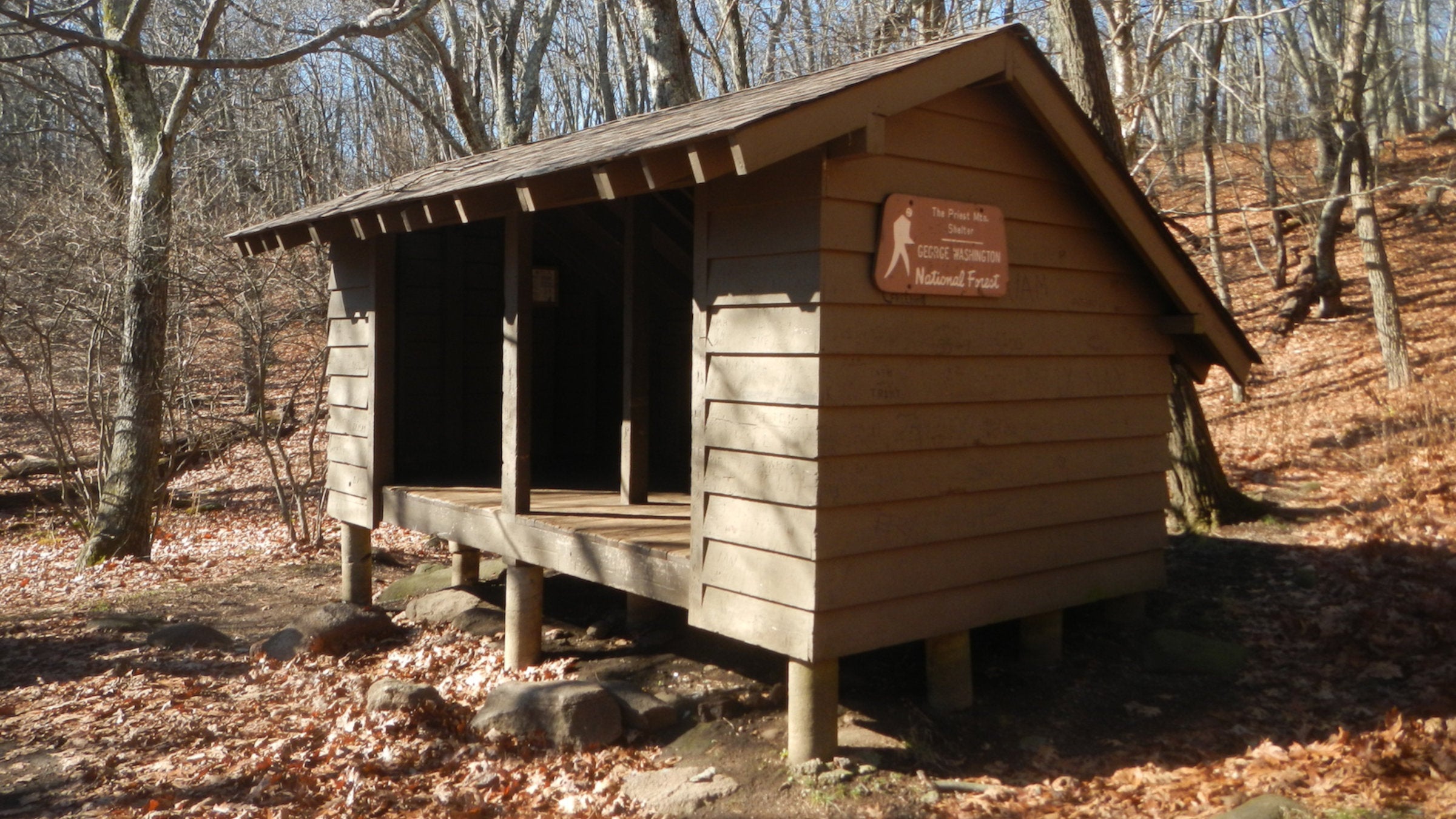The Appalachian Trail Shelter Where Thru-Hikers Confess Their Sins

The Priest Shelter doesn't stand out from most other AT shelters. (Photo: PlumbBobM / Trailforks)
When I arrived at the Priest on my thru-hike of the Appalachian Trail in 2015, I didn’t quite grasp the cultural significance of the place. I arrived at the camping area, barely noticing the unassuming structure before setting my expedition hammock up in the woods. Once my trail chores were complete, I followed the sound of laughter back to the shelter, where my friends were reading the shelter log.
“Listen to this,” one friend said. “This person dropped a baseball-size rock in someone else’s backpack. They didn’t notice for a full day,” we giggled under the drooping sun. Then they added their own tales, admitting to trail crushes and other impure thoughts.
Appalachian Trail thru-hikers love traditions. As soon as we traipse into the woods, we adopt new names. A stop at Pine Grove Furnace State Park demands that we partake in the half gallon challenge, consuming our fill of ice cream within an hour. In New Hampshire, many of us moon the Cog locomotive while it climbs Mt. Washington. And when we reach the Priest Shelter in Virginia, it’s time to confess our sins.
Why is it called the “Priest Shelter”?
There are a few different stories surrounding the origins of the Priest Shelter’s name. One such myth suggests that the shelter was named after the influential DuPriest family that lived in the region and owned a lot of property in the area. Another theory is that it was named after a pastor from the area who lived as a hermit.
What we do know is trail builders established the shelter after a major re-route of the AT after World War II. The shelter sits on top of the tallest peak in the “religious range” in Amherst County, which also includes the Cardinal and the Friar.
Why do we confess our sins to the Priest?
No one knows exactly why the tradition of confessing your secrets started or when it began. Some records date back to the 1980s, when hikers were already making confessions. A popular theory surrounding the culture of the Priest Shelter suggests that the rugged, 4.3-mile, 3,100-foot climb up the mountain feels like penance to hikers, so many people feel that they might as well confess to the sin for which they just suffered.
What do hikers confess at the Priest?
Sometimes confessions are grisly, heartbreaking, or heavy (including, allegedly, at least one that admits to a killing.) But more commonly, Priest Shelter confessions fall on the comedic side of the scale, detailing stories about stolen Pop-Tarts and lust for all-you-can-eat buffets.
Some hikers cling to secrecy, choosing to leave their confessions in the Priest log book, but others are more inclined to share them with the world. In a Youtube vlog taken amidst classic Appalachian Trail rain, Bear Trek Adventures confessed, “I’ve had impure thoughts many, many times on this trip, staying in the shelters, I think quite often about cutting someone’s sleeping pad that snores in the shelter just so I can get a peaceful night’s sleep.”
“I told my wife that if she let me quit my job to hike the AT that I would shave the beard when I’m done,” he went on. “I’m sorry babe, but that is not going to happen. The beard will live on long after I’m done with my hike.”
Like Bear Trek Adventures, an episode of the Green Tunnel Podcast includes multiple hiker confessions shared from the logbook. Amber Pelham states, “Forgive me father for I have sinned. I tell dayhikers I am so hungry to solicit free food.”
“Forgive me trail father or don’t, for I have no shame,” Rachel Birch adds. “Sometimes I sing Christmas songs out loud despite the suffering that it will cause to my fellow hikers.”
“Forgive me father for I have sinned,” Alexandra Miller confesses. “I have lived the majority of my life without a mullet. The horror.”
Other common confessions include “yellow blazing” (hitchhiking past sections of trail), or even “pink blazing” (when hikers travel along the trail in pursuit of love).
Getting to the Priest Shelter
Priest Mountain is a popular Virginia peak for hikers of all kinds. While it’s located in a designated wilderness area, the region receives a lot of foot traffic, likely in part due to the peak’s high elevation. In fact, the Priest Mountain is the last 4,000-foot mountain along the Appalachian Trail until northbound hikers reach Mt. Moosilauke in New Hampshire.
The Priest Shelter is situated just south of the Tye River in Virginia in the Priest Wilderness, a 5,994-acre area established in 2000. The fern, rhododendron, and azalea-covered ground looks like something out of a fairy tale during the spring and summer, and the mountain summit offers sweeping views of the valley below.
Located at Appalachian Trail mile marker 829.7, those who are visiting the area for the day or weekend typically park at the trailhead on Crabtree Falls Highway. You might also approach the shelter from Route 56 at the Tye Trailhead, heading southbound along the Appalachian Trail.
Today, the Priest Shelter serves as a testament to the Appalachian Trail culture, which is ripe with humor and tradition. A stop at this destination not only offers hikers a respite from the challenging terrain but also a look into the lives of the people they’re sharing the trail with, whether they’re ready for it or not.